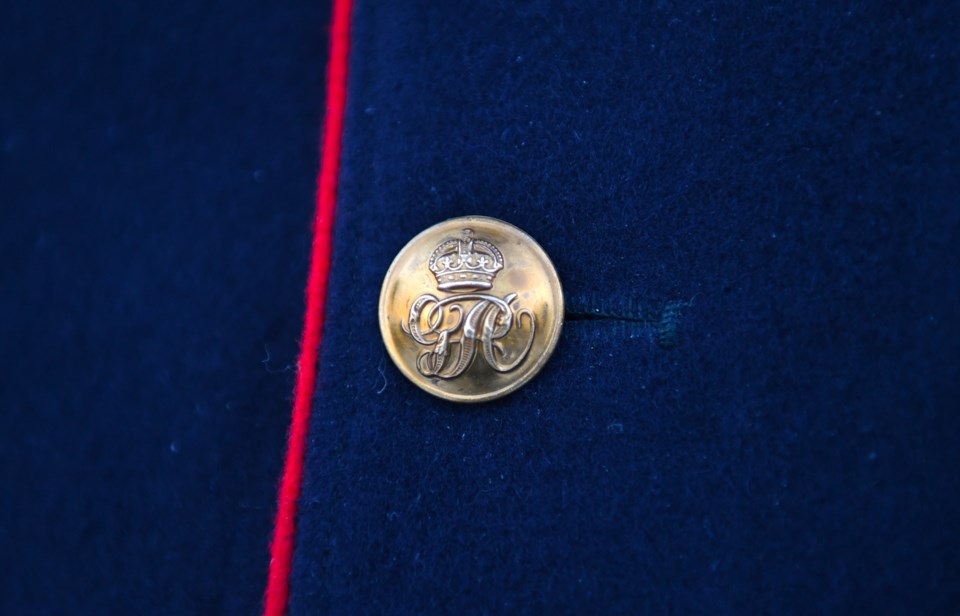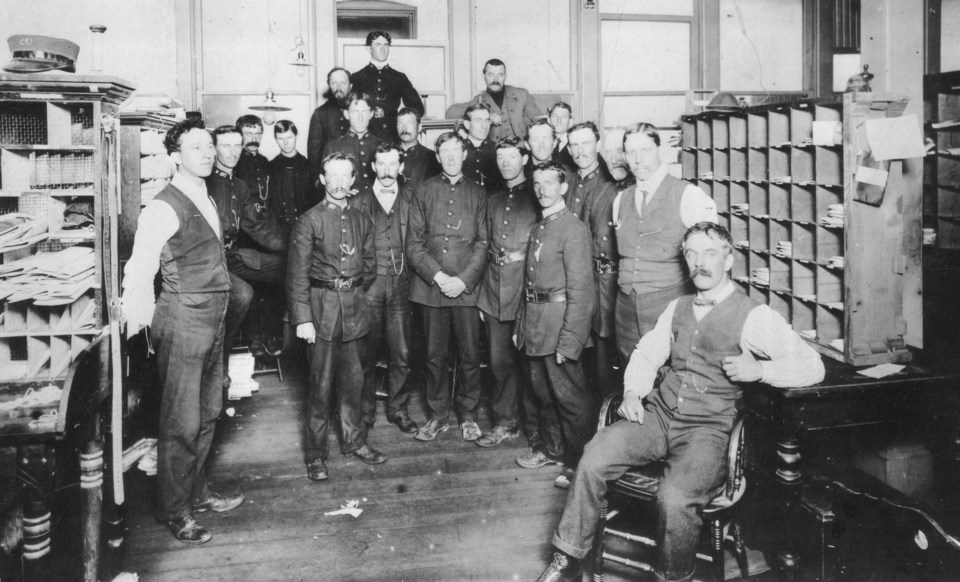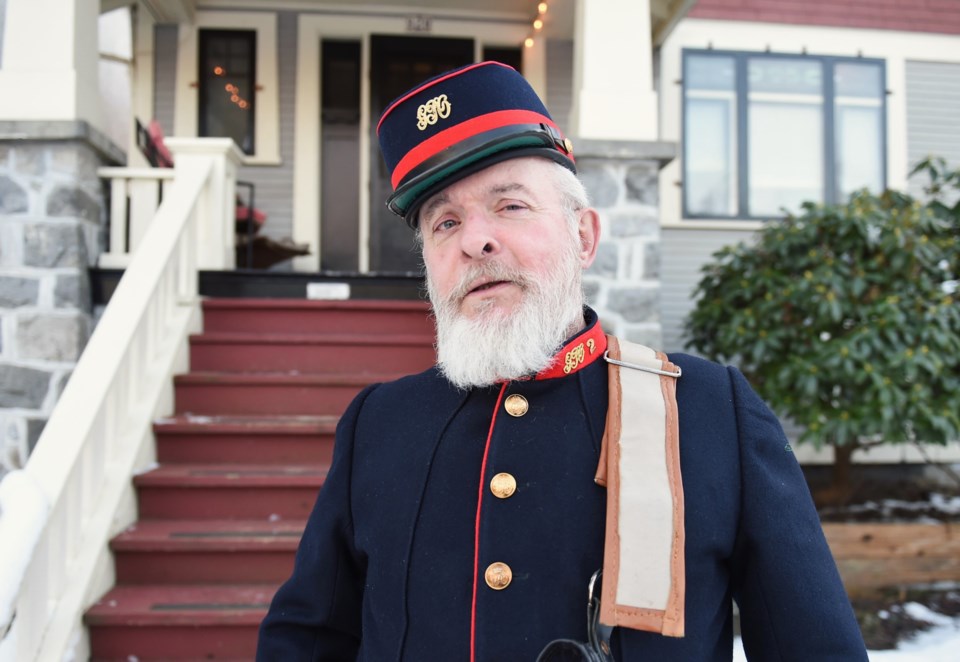The first time mail was delivered to Vancouver homes was Feb. 2, 1895, as four men began walking their routes around the young city.
Now, 130 years later, people in Fairview may spot someone delivering the mail dressed the same as those predecessors.
Canada Post worker Rob MacDonald's daily route is around West 12th Avenue between Oak and Hemlock streets. This month, he is delivering the mail wearing a uniform he and a colleague meticulously recreated to mark the 130th anniversary of mail delivery in Vancouver.
The navy blue uniform with red details and gold-plated buttons was made by MacDonald and Parker McIntosh, a historical tailor.
"I'm a letter carrier by day, and a kilt maker and tailor by night," says MacDonald, who's been showing McIntosh his craft for about a decade.
Creating the historical uniform
The idea began in 2022 when a poster was put up at post offices about the early days of the service; before MacDonald was done reading he was already planning his own uniform.
"I had this idea that what better way to commemorate the 130th anniversary was to recreate the uniform of posties of 1895 and also find out a little bit about their lives," explains MacDonald.
He and McIntosh researched the uniform to recreate it as closely as possible. Luckily, at the same time, someone on eBay was selling a postal service collar from about 120 years ago.
"Rob had bought the collar. He asked me, 'Do you think we could do this?'" says McIntosh. He figured they could if someone was making the right cloth.
"I said 'If anyone has the cloth, it's going to be KP Historic Textiles," he continues. "They said they were making it. It would be about a year out. And so we spent about a year gathering our reference material."
The company had just started making the exact cloth needed; it's also used for British military reenactments
"The original [Vancouver postal] uniforms were procured through the military back in the 19th century," explains McIntosh.

MacDonald also found someone selling dozens of buttons.
"These are the slightly later pattern," MacDonald notes. "This is the king's crown, which came in in 1902, 1903, and was worn until '50 or '52."
The buttons are gold plated, which would have been a rarity for working-class people in B.C. in the 1890s.
While they had a photo of the first four letter carriers in Vancouver from the front, photos of the back of the uniforms were hard to find.
MacDonald contacted the postal museum in England, which sent reference photos from their collection and information about how uniforms were made.
For the hat, they snared Jim Keller, a historic hat maker and the belt was done by a leather worker, both based in Ontario.
McIntosh has a personal library of historical tailoring books and was able to get almost step-by-step instructions to recreate the uniform. They also found army tunics from the same period for reference, since they would have been the basis for the postal uniforms.
The importance of a uniform
Originally, mail in Vancouver was held at hotels or stores and people would have to go pick it up, like PO boxes at a store these days.
In 1895, Vancouver's delivery system was set up with four routes walked by four letter carriers sporting the authoritative uniforms.

Today, postal workers' gear is much more practical, but not as formal as the custom-tailored and thick, stiff wool of the 1895 uniform.
"Instead of going down to the basement and picking through some used clothing, they walked you down to a tailor, probably on Dunsmuir Street where, for the first time in your working-class life, you were measured for a suit. A new suit," says MacDonald.
Becoming a letter carrier was a big deal with a sworn oath and high pay.
Mail delivery was an important service at the time; it was the only real way to communicate with someone who wasn't standing nearby. Laws around the theft of mail were harsh, and postal workers were well-treated to dissuade bribery.
Delivering mail 130 years ago in Vancouver
While the goal is the same, there are some differences between mail delivery in 1895 and 2025.
"They'd work six days a week," says MacDonald. "They'd show up at five in the morning or earlier. They'd fall in for inspection. 'Is your tunic clean? Has your belt been polished?'"
"And then there'd be some brief words, 'Okay, somebody saw a bull elk at the corner of Alberni in Georgia. Keep your eyes open.'"
The letter carriers would then sort the mail for their route, pack their satchel, and head out, often on foot, stopping to pick up mail being sent out.
After a lunch of "a hefty wedge of meat pie, a couple of boiled potatoes, and a good strong cup of tea," the mailmen would sort through the new mail for destinations in Vancouver and prepare a second delivery in the afternoon.
"It was tremendous," MacDonald says of the city's earliest letter carriers.
Return of the 1895 letter carrier uniform to the streets of Vancouver
MacDonald is capturing a bit of that spirit as he wears his 1895 garb on his 2025 Fairview route.
The replica uniform isn't for theatre or to be kept in a display case but is being worn by MacDonald every workday in February.
"I've been wearing it since February 3, and I'm gonna be wearing it for the full month," MacDonald says.
He notes that he didn't really have permission to wear the uniform on the job from Canada Post. It doesn't match 21st-century standards.
"The comment was made that I that I really should be wearing high visibility clothing," says MacDonald. "And my reaction, my retort was, 'Well, the whole purpose is to be noticed, and if you're not going to notice somebody walking in an 1895 uniform, you probably shouldn't be driving."

The feedback from the public as he delivers mail in the Fairview neighbourhood has been overwhelmingly positive.
"All I've gotten is people stopping asking if I am a traffic warden or soldier," says MacDonald.
The uniform has also affected MacDonald as he walks his route.
"I put this on, I immediately square my shoulders. And I can't say the same when I put that [high visibility clothing]."
When February ends he's not sure what will happen to the special suit.
"Frankly, I want to keep wearing it till it's too hot to wear because it looks good, it feels good," he says. "It's slowly breaking in."



